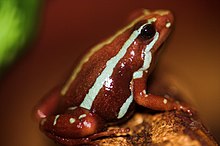Epipedobates
| Epipedobates | |
|---|---|

| |
| Epipedobates tricolor | |
| Scientific classification | |
| Domain: | Eukaryota |
| Kingdom: | Animalia |
| Phylum: | Chordata |
| Class: | Amphibia |
| Order: | Anura |
| Family: | Dendrobatidae |
| Subfamily: | Colostethinae |
| Genus: | Epipedobates Myers, 1987 |
| Type species | |
| Prostherapis tricolor Boulenger, 1899
| |
| Diversity | |
| 7 species (see text) | |
Epipedobates is a group of poison dart frogs. They live in northern South America (Colombia and Ecuador) west of the Andes Mountains and on the west sides of the mountains. People call them phantasmal poison frogs in English.[1]
Taxonomy
[change | change source]Scientists made the group Epipedobates in 1987 because they wanted to take the big family Dendrobatidae and put it in smaller groups, especially species that had been in the genus Phyllobates. In 2006, scientists moved many of the frogs in Epipedobates to Ameerega, leaving five.[2] The species count of Epipedobates had increased to seven by early 2024.[1]
Bodies
[change | change source]The skin of the frogs' backs is colored brown to make them hard to see. There is a light stripe down the side of the body. The skin of the back is smooth or has only a few small bumps. In adult males, third finger is fat.[2]
Species
[change | change source]There are seven species:[1][3]
| Image | Scientific name | Common name | Distribution |
|---|---|---|---|
 |
Epipedobates anthonyi (Noble, 1921) [4] | Anthony's poison arrow frog | Ecuador and Peru. |
| Epipedobates boulengeri (Barbour, 1909)[5][6] | marbled poison frog or marbled poison-arrow frog | Colombia (Cauca, Nariño, Valle del Cauca Departments, including Gorgona Island) and northwestern Ecuador | |
 |
Epipedobates espinosai (Funkhouser, 1956) [7] | Ecuador | |
| Epipedobates machalilla (Coloma, 1995) [8] | West Ecuador | ||
| Epipedobates maculatus (Peters, 1873) | Confusing Poison Frog | Panama | |
| Epipedobates narinensis (Mueses-Cisneros, Cepeda-Quilindo, and Moreno-Quintero, 2008)[9] | Colombia | ||
 |
Epipedobates tricolor (Boulenger, 1899) [10] | Phantasmal poison frog | Ecuador |
References
[change | change source]- ↑ 1.0 1.1 1.2 Frost, Darrel R. (2024). "Epipedobates Myers, 1987". Amphibian Species of the World: an Online Reference. Version 6.2. American Museum of Natural History. Retrieved 17 June 2024.
- ↑ 2.0 2.1 Grant, T.; Frost, D. R.; Caldwell, J. P.; Gagliardo, R.; Haddad, C. F. B.; Kok, P. J. R.; Means, D. B.; Noonan, B. P.; Schargel, W. E. & Wheeler, W. C. (2006). "Phylogenetic systematics of dart-poison frogs and their relatives (Amphibia: Athesphatanura: Dendrobatidae)" (PDF). Bulletin of the American Museum of Natural History. 299: 1–262. doi:10.1206/0003-0090(2006)299[1:PSODFA]2.0.CO;2. S2CID 82263880. Archived from the original (PDF) on 2009-02-26. Retrieved 2008-09-22.
- ↑ "Dendrobatidae". AmphibiaWeb: Information on amphibian biology and conservation. [web application]. Berkeley, California: AmphibiaWeb. 2015. Retrieved 17 April 2015.
- ↑ Noble, Gladwyn Kingsley (30 Dec 1921). "Five new species of Salientia from South America". American Museum Novitates (29): 1–7. hdl:2246/4615.
- ↑ Barbour, Thomas (1909). "Corrections regarding the names of two recently described Amphibia Salientia" (PDF). Proceedings of the Biological Society of Washington. 22: 89.
- ↑ Barbour, Thomas (1905). "The Vertebrata of Gorgona Island, Colombia: Reptilia; Amphibia". Bulletin of the Museum at Harvard College. 46 (5): 98–102.
- ↑ Funkhouser, John W. (17 September 1956). "New frogs from Ecuador and southwestern Colombia". Zoologica: Scientific Contributions of the New York Zoological Society. 41 (9): 73–80. doi:10.5962/p.190356. S2CID 90986498 – via Biodiversity Heritage Library.
- ↑ Coloma, Luis A. (13 September 1995). "Ecuadorian frogs of the genus Colostethus (Anura: Dendrobatidae)". University of Kansas Natural History Museum. 87: 1–72 – via Biodiversity Heritage Library.
- ↑ Mueses-Cisneros, Jonh Jairo; Cepeda-Quilindo, Belisario; Moreno-Quintero, Viviana (2008). "Una nueva especie de Epipedobates (Anura: Dendrobatidae) del suroccidente de Colombia". Papéis Avulsos de Zoologia. 48 (1). doi:10.1590/s0031-10492008000100001. ISSN 0031-1049.
- ↑ Boulenger, G.A. (December 1899). "LII—Descriptions of new Reptiles and Batrachians collected by Mr. P. O. Simons in the Andes of Ecuador". Annals and Magazine of Natural History. 4 (24): 454–457. doi:10.1080/00222939908678229. ISSN 0374-5481.
